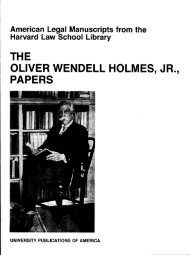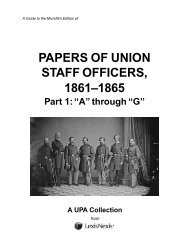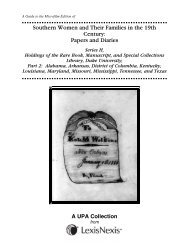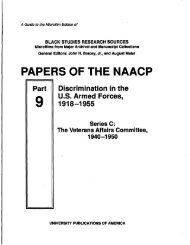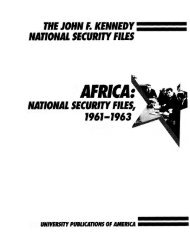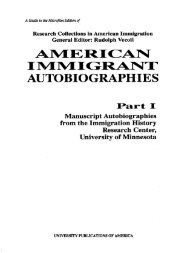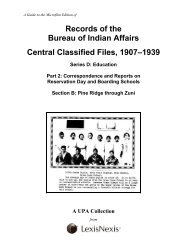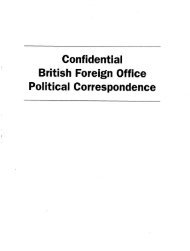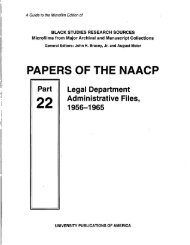Create successful ePaper yourself
Turn your PDF publications into a flip-book with our unique Google optimized e-Paper software.
SCOPE AND CONTENT NOTE<br />
The Treaty of Peace with Japan, signed September 8, 1951, in San Francisco,<br />
California, officially ended the Second World War and effectively established a<br />
permanent U.S. presence in Northeast Asia. Confidential U.S. State Department<br />
Special Files Northeast Asia, First Supplement, 1945–1966, chronicles the Japanese<br />
postwar economic miracle, including Japan’s global integration, along with the<br />
outbreak of hostilities on the Korean peninsula and the ongoing diplomatic and<br />
military struggle between Chinese Nationalists in Taiwan and Communists on<br />
China’s mainland.<br />
The collection opens with the Japanese Peace Treaty, particularly focused on the<br />
international response and Japan’s efforts at reconciliation with Asian neighbors it<br />
had once occupied. National Security Council papers document the critical role of the<br />
Supreme Commander of the Allied Powers (SCAP) in fostering economic recovery in<br />
Japan to fortify vital U.S. cold war interests (Reel 1, Frame 0885). Reel 2 is solely<br />
devoted to Military Assistance Program files, covering Taiwan, Japan, and Korea.<br />
The Far Eastern Commission (FEC), established in December 1945, administered<br />
the U.S. occupation of Japan, setting policy and reforming the Japanese Constitution<br />
(Reel 3, Frames 0001–0230, 0595–0692).<br />
Focus narrows to the U.S. occupation of the Ryukyu Islands, including Okinawa,<br />
in Reel 4. Reforms that integrated cooperation in Japan between the government and<br />
private industry spurred the establishment of the Ryukyu Life Insurance Company,<br />
Ltd. and the Ryukyu Warehouse Corporation (Reel 5, Frames 0001–0797). Loaning<br />
practices at the Bank of the Ryukyus, common throughout postwar Japan, led to the<br />
rise of keiretsu (Reel 4, Frames 0617–0850).<br />
Lists and dossiers of soldiers missing in action and prisoners of war from the<br />
Korean Conflict compose Reels 7–9. With over 8,100 American soldiers missing in<br />
action, the United States relied heavily on the International Committee of the Red<br />
Cross to provide information in the years following the war (Reel 8, Frames 0466–<br />
0763).<br />
Beginning with Frame 0258 on Reel 9, Special Files Northeast Asia covers myriad<br />
miscellany, from legislative and legal affairs to visas to aid and finance. Reels 11 and<br />
12 are mainly comprised of political affairs, covering international diplomatic<br />
recognition for the People’s Republic of China (PRC), foreign relations between the<br />
Republic of China (ROC) and over a dozen states in Europe, the Middle East, and<br />
Asia, as well as extensive materials on diplomatic visits and meetings throughout<br />
1964 (Reel 11, Frame 0457–Reel 12, Frame 0109). This collection offers pervasive<br />
coverage of PRC attempts to win diplomatic recognition in the United Nations (UN),<br />
ultimately culminating in the passage of UN General Assembly Resolution 2758 in<br />
October 1971 (Frames 0431–0816 of Reel 11). With the ROC expulsion from all UN<br />
organs, including the Security Council, the PRC assumed its seat at the UN.<br />
Japanese economic development emerges at the end of Reel 12. Rapid economic<br />
liberalization prompted Japan to join GATT in 1963, the IMF, and OECD in 1964,<br />
v



